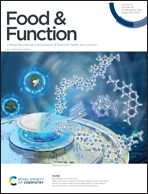Antioxidant and pro-oxidant phytochemicals in ultrasound and microwave assisted extracts from hop cones: a statistical modelling approach†
Abstract
The present study investigated the relationships between different green extracts from hop cones (HGEs) and their cytoprotective/cytotoxic effects on human cultured colonocytes, using a multivariate statistical approach. HGEs were obtained by ultrasound (US) and microwave (MW) assisted extraction, using food grade solvents (ethanol and ethanol : water = 50 : 50 mixture). Their chemical fingerprinting showed the presence of 21 bioactive compounds belonging to the classes of polyphenols, prenylcalcones and floroacylglucinols, which were more abundant in MW ethanolic extracts. All the extracts, except for the US hydroalcoholic one, exerted a cytotoxic effect in a dose-dependent manner. HGEs did not alter the cellular redox status at low doses, while at the highest concentrations considered they displayed a pro-oxidant or antioxidant activity. Chemometric analysis revealed the compounds most correlated with cellular toxicity and/or ROS production and that the differences observed in Caco2 cells could be adequately explained by 2D statistical models including inhibitor-promoting agent pairs.



 Please wait while we load your content...
Please wait while we load your content...